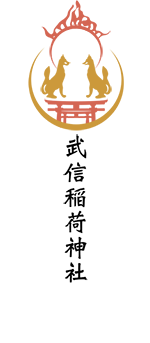境内末社
宮姫社(Miyahime-sha)
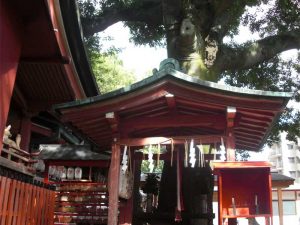 Sarasvati(Benzaiten/弁財天) who dwells on the sacred hackberry tree(榎/Enoki) is enshrined in this Miyahime-sha. It is said that this sacred tree was transplanted from Itsukushima jinja-shrine in Itsukushima (Hiroshima) by TAIRA no Shigemori at the end of Heian period. This tree is the oldest and biggest sacred tree in old Kyoto, and it has been designated as a special natural treasure by Kyoto city. It has been worshipped as the God of health and long life for the vitality and energy of this more than 800 year-old tree. So many worshipers who put their hands on the tree to share the power of the tree never end. Also, this Enoki tree has the similar sound of En(縁)-no-ki, which means “the tree of good relationship”, so this Miyahime-sha is known for the God of love and relationship. In old times, arranged marriage meetings were often set under this tree. Even now, many visitors worship this shrine for the good relationship.
Sarasvati(Benzaiten/弁財天) who dwells on the sacred hackberry tree(榎/Enoki) is enshrined in this Miyahime-sha. It is said that this sacred tree was transplanted from Itsukushima jinja-shrine in Itsukushima (Hiroshima) by TAIRA no Shigemori at the end of Heian period. This tree is the oldest and biggest sacred tree in old Kyoto, and it has been designated as a special natural treasure by Kyoto city. It has been worshipped as the God of health and long life for the vitality and energy of this more than 800 year-old tree. So many worshipers who put their hands on the tree to share the power of the tree never end. Also, this Enoki tree has the similar sound of En(縁)-no-ki, which means “the tree of good relationship”, so this Miyahime-sha is known for the God of love and relationship. In old times, arranged marriage meetings were often set under this tree. Even now, many visitors worship this shrine for the good relationship.
龍馬とおりょうの逸話
伏見遙拝所(Fushimi worship from afar)
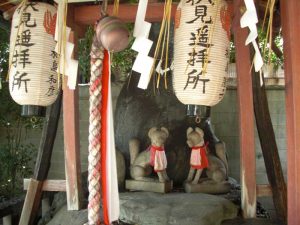 You can worship Fushimi Inari shrine from here. This is the place for that.
You can worship Fushimi Inari shrine from here. This is the place for that.
南末社三社(South three subordinate shrines)
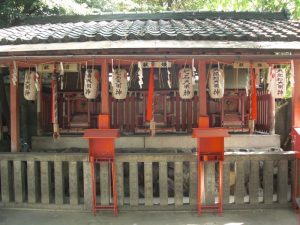 ・白清大明神(Hakusei Daimyojin)
・白清大明神(Hakusei Daimyojin)
・七石大明神(Nanaishi Daimyojin)
・太郎松大明神(Taromatsu Daimyojin)
釘抜き大明神(Kugi-nuki Daimyojin)
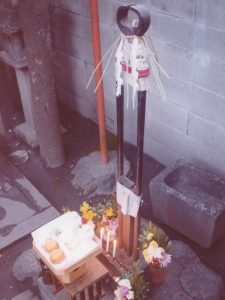 In ancient times, a blacksmith master suffered from diseases and disasters. But when he was striking an iron while praying for the God of Takenobu inari jinja shrine, the iron became a shape of pincers (Kugi-nuki). They enshrined this pincer-shaped iron in the precinct. Then the master’s illness and other disaster disappeared and the master’s family had a happy life ever after. This iron has been worshipped as Kugi-nuki Daimyojin, and called “Kugi-nuki san.” It is said that Kugi-nuki Daimyojin would heal your pain or illness if you stroke your body parts where you feel pain and then stroke Kugi-nuki san.
In ancient times, a blacksmith master suffered from diseases and disasters. But when he was striking an iron while praying for the God of Takenobu inari jinja shrine, the iron became a shape of pincers (Kugi-nuki). They enshrined this pincer-shaped iron in the precinct. Then the master’s illness and other disaster disappeared and the master’s family had a happy life ever after. This iron has been worshipped as Kugi-nuki Daimyojin, and called “Kugi-nuki san.” It is said that Kugi-nuki Daimyojin would heal your pain or illness if you stroke your body parts where you feel pain and then stroke Kugi-nuki san.
北末社二社(North two subordinate shrines)
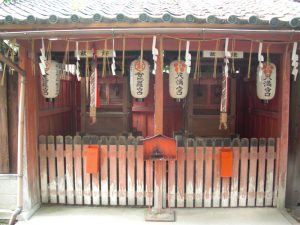 ・天満宮(Tenman-gu)
・天満宮(Tenman-gu)
・金毘羅宮(Kompira-gu)
白蛇社(Shirohebi-sha/弁財天Benzaiten)
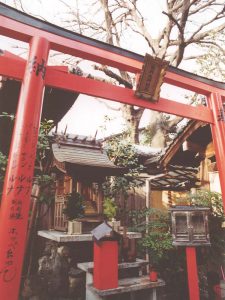 A white snake is a symbol of Sarasvati(Benzaiten/弁財天). Benzaiten, who had lived in this area since ancient times and turned into a white snake, once appeared in front of an ascetic, who had a profound belief against Gods and Buddha. She said to him, “I will go out into the world to protect people.” Then she was enshrined by those who believed and grateful to her words.
A white snake is a symbol of Sarasvati(Benzaiten/弁財天). Benzaiten, who had lived in this area since ancient times and turned into a white snake, once appeared in front of an ascetic, who had a profound belief against Gods and Buddha. She said to him, “I will go out into the world to protect people.” Then she was enshrined by those who believed and grateful to her words.
One day, in a dream of the ascetic, Benzaiten who changed into a white snake showed up and said, “I will come into the world to protect people. Enshrine me in the precinct which has 13 shrines altogether and deeply believe in me.” The ascetic looked for the precinct that is the same as what he saw in the dream. Finally he found Takenobu-inari jinja shrine. In this area, white snakes often had been seen by residents, so the ascetic and other people had no doubt that this is the place for enshrining. This shrine is called “Shirohebi-sha”, which means “a shrine of White Snake.” Benzaiten has been recognized as a god of business prosperity, skill improvement and wealth, so she gives such power to people who pray to her.
起上大明神(大黒社)
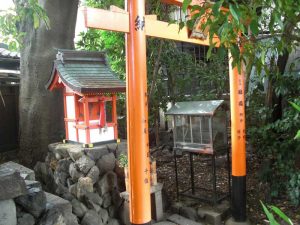 七福神で有名な大黒様をお祀りしています。本来は日本の御祭神は大国主命(おおくにぬし)ですが、大黒=大国(どちらもだいこく)のため同一視されます。
七福神で有名な大黒様をお祀りしています。本来は日本の御祭神は大国主命(おおくにぬし)ですが、大黒=大国(どちらもだいこく)のため同一視されます。
起上大黒の名前通り、起き上がる、飛躍していく、躓いても起き上がると、発展、飛躍、事業仕事運、財運向上等の御利益を授けて頂けます。参拝者、近隣の人々からは「だいこくさん」と親しまれています。
御塚
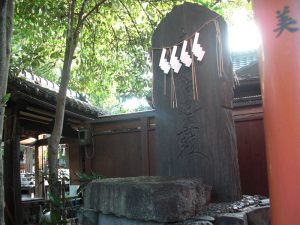 法華経の御塚です
法華経の御塚です
武春大明神
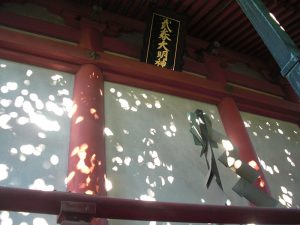 御本社裏座にお祀りされています。
御本社裏座にお祀りされています。
A sacred dragon came out from the sacred tree
There is a hackberry tree in the precinct of this shrine which is about 850 years old. It is said that a goddess called “Sarasvati(Benzaiten/弁財天)”, who presides over water, property and performing arts, dwells in it. So it has been regarded as “the sacred tree.” But unfortunately, a hollow branch snapped off in August, 2013. Then Keiji Kidokoro, who won the world championship of an art of chainsaw carving, made it turn into “a sacred dragon” which is called Ryu (龍, the shape is a kind of dragon, but it presides over rain and has been had a firm religious faith) in Japanese.
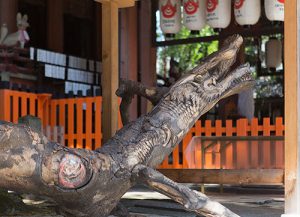 This branch is about 10 meters long and 1.5 meters in diameter. The crack was a bit southern part above the Temple. It snapped off, but we couldn’t dispose of it easily because it was a part of a believed sacred tree. Moreover it was divine and overwhelming even though it was just a part of the tree. Then we decided that we would keep it as an art of chainsaw carving to show this forceful figure.
This branch is about 10 meters long and 1.5 meters in diameter. The crack was a bit southern part above the Temple. It snapped off, but we couldn’t dispose of it easily because it was a part of a believed sacred tree. Moreover it was divine and overwhelming even though it was just a part of the tree. Then we decided that we would keep it as an art of chainsaw carving to show this forceful figure.
We just asked him to bring out the best in this branch and left everything to him. He said that he felt the power of the sacred dragon hidden in this branch the moment he saw it. He tried to maintain the state of surface and texture as much as possible.
For that, he carved only the left side from the front of the dragon. However, even if you stare at this sculpture from the right side, you can find the eye, mouth and strongly waving body.
The mark like a flame on the abdomen is a symbol of Inari shrine, but it was not made by chainsaw but has been here since we found this branch. Though some decorations were added, this miraculous coincidence should be something like a proof that this dragon came from the Goddess’ branch.
The end of the Edo era(19C), there was a samurai whose name was Ryoma Sakamoto. He is one of the most famous and popular samurai in Japan because of his negotiation and mediation skills. But at that time there were complicated political conflicts and he was one of the victims, which means he was assassinated.
He had a wife, whose name was Oryo. There is an anecdote about this couple that he carved the letter “龍” which is read as “ryu” and “ryo” on this tree. Now we can’t find this letter, but it is also mysterious that this dragon(龍) was carved out from this old tree.
